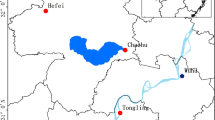Abstract
In this study, an extension of the TREC (Tracking Radar Echo by Correlations) technique, named Tropical Cyclone (TC) circulation TREC (T-TREC), is developed to retrieve the winds of landfalling typhoons in China. The T-TREC analysis is performed on a polar grid centered at the TC center, using arc-shaped correlation cells and an arc-shaped search area. The search for the best correlation match is confined along the cyclonic direction with a limited search distance in the radial direction based on the cyclonic circulation characteristics of TCs in the Northern Hemisphere. The TC center is determined objectively using reflectivity data while the Doppler radar radial velocities are incorporated to estimate the search range and create a velocity correlation matrix as auxiliary constraints.
The T-TREC was applied to the landfalling Typhoon Saomai (0608) observed by Chinese next generation Weather Surveillance Radar 1998 Doppler (CINRAD WSR-98D) on the southeast coast of China. The results show that the T-TREC has the ability to estimate the typhoon circulation with an average bias of < 4 m s−1. The incorporation of radial velocity data could distinctively improve wind retrievals for intense typhoons, especially by reducing the underestimation caused by fairly uniform reflectivity patterns in the vicinity of the eyewall and the outer rainband. A quantitative evaluation of the influence of typhoon center and cell size on the wind estimation demonstrates that the quality of the T-TREC retrieved wind circulation depends on the estimation of the typhoon center. A 4-km deviation of the TC center may result in a 10% increase in the retrieved wind error. The effect of cell size depends on the typhoon scale: better wind retrieval results can be obtained for a smaller typhoon.
Similar content being viewed by others
References
Brown, R. A., and V. T. Wood, 1983: Improved severe storm warning using Doppler radar. National Weather Digest, 8(3), 19–27.
Chang, P. L., 2000: Circulation change analysis on landfalling typhoon: A case study of Herb (1996). Ph. D. thesis, Natl. Taiwan Univ., Taipei, Taiwan, 121 pp.
—, B. J. D. Jou, and J. Zhang, 2009: An algorithm for tracking eyes of tropical cyclones. Wea. Forecasting, 24, 245–261.
Frank, W. M., 1977: The structure and energetics of the tropical cyclone. Part I: Storm structure. Mon. Wea. Rev., 105, 1119–1135.
Harasti, P. R., C. J. McAdie, P. P. Dodge, et al., 2004: Real-time implementation of single-Doppler radar analysis methods for tropical cyclones: Algorithm improvements and use with WSR-88D display data. Wea. Forecasting, 19, 219–239.
Lee, W. C., F. D. Marks, and R. E. Carbone, 1994: Velocity track display: A technique to extract real-time tropical cyclone circulations using a single airborne Doppler radar. J. Atmos. Oceanic Tech., 11, 337–356.
—, B. J. D. Jou, P. L. Chang, and S. M. Deng, 1999: Tropical cyclone kinematic structure retrieved from single-Doppler radar observations. Part I: Interpretation of Doppler velocity patterns and the GBVTD technique. Mon. Wea. Rev., 127, 2419–2439.
—, and F. D. Marks, 2000: Tropical cyclone structure retrieved from single Doppler radar observations. Part II: The GBVTD-simplex center finding algorithm. Mon. Wea. Rev., 128, 1925–1936.
Li, P. W., W. K. Wong, K. Y. Chan, and S. T. Lai, 2000: SWIRLS-An Evolving Nowcasting System. Technical Note No. 100, Hong Kong Observatory.
Marks, F. D., and R. A. Houze, 1984: Airborne Doppler radar observations in Hurricane Debby. Bull. Amer. Meteor. Soc., 65, 569–582.
—, and R. A. Houze, 1987: Inner core structure of Hurricane Alicia from airborne Doppler radar observations. J. Atmos. Sci., 44, 1296–1317.
—, R. A. Houze, and J. F. Gamache, 1992: Dual-aircraft investigation of the inner core of Hurricane Norbert. Part I: Kinematic structure. J. Atmos. Sci., 49, 919–942.
Oye, R., C. Mueller, and S. Smith, 1995: Software for radar translation, visualization, editing, and interpolation. Preprints, 27th Conference on Radar Meteorology, Vail, CO, Amer. Meteor. Soc., 359–361.
Pan Yujie, Zhao Kun, and Pan Yinong, 2008: Single-Doppler radar observations of a high precipitation supercell accompanying the 12 April 2003 severe squall line in Fujian Province. Acta Meteor. Sinica, 24(1), 50–65.
Ray, P. S., K. K. Wagner, K. W. Johnson, et al., 1978: Triple-Doppler observations of a convective storm. J. Appl. Meteor., 17, 1201–1212.
Rinehart, R. E., and E. T. Garvey, 1978: Threedimensional storm motion detection by conventional weather radar. Nature, 273, 287–289.
Roux, F., and F. D. Marks, 1996: Extended velocity track display (EVTD): An improved processing method for Doppler radar observations. Part I: Kinematics. Mon. Wea. Rev., 123, 2611–2639.
Shea, D. J., and W. M. Gray, 1973: The hurricane’s inner core region. Part I: Symmetric and asymmetric structure. J. Atmos. Sci., 30, 1544–1564.
Tuttle, J., and R. Gall, 1999: A single-radar technique for estimating the winds in tropical cyclones. Bull. Amer. Meteor. Soc., 80, 653–668.
Tuttle, J. D., and G. B. Foote, 1990: Determination of the boundary layer airflow from a single Doppler radar. J. Atmos. Oceanic Tech., 7, 218–232.
Wan Qi-lin, Xue Ji-shan, Chen Zhi-tong, and Liu Chunxia, 2005: The test of applying radar TREC wind in three-dimensional variational assimilation. J. Trop. Meteor., 21(5), 449–457. (in Chinese)
Willoughby, H. E., 1992: Linear motion of a shallowwater barotropic vortex as an initial-value problem. J. Atmos. Sci., 49, 2015–2031.
—, 1998: Tropical cyclone eye thermodynamics. Mon. Wea. Rev., 126, 1653–1680.
Zhao Kun, Lee Wenchau, and Ben Jong-Dao Jou, 2008: Single Doppler radar observation of the concentric eyewall in Typhoon Saomai, 2006, near Landfall. Geophys. Res. Lett., 35, L07807, doi: 10.1029/2007GL032773.
—, B. J. D. Jou, Pan Yujie, and Ge Wenzhong, 2009: Single-Doppler radar analysis of a mesocyclone in the Taiwan Strait. Acta Meteor. Sinica, 23(2), 140–155.
Author information
Authors and Affiliations
Corresponding author
Additional information
Supported by the “973” National Key Basic Research Program of China under Grant No. 2009CB421502 and the National Natural Science Foundation of China under Grant Nos. 40505004, 40333025, and 40975011.
Rights and permissions
About this article
Cite this article
Wang, M., Zhao, K. & Wu, D. The T-TREC technique for retrieving the winds of landfalling typhoons in China. Acta Meteorol Sin 25, 91–103 (2011). https://doi.org/10.1007/s13351-011-0007-x
Received:
Published:
Issue Date:
DOI: https://doi.org/10.1007/s13351-011-0007-x




